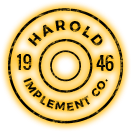Planting for a Quick Fall Harvest
 At this point, you’ve probably pulled up all your summer harvests and crops and sold them off or used them up. If you think that’s the end of your garden or fieldwork until the spring, you’ll be surprised to learn that you can actually get one last harvest in before the cold comes in. Some vegetables are hardy enough, and grow quickly enough, that you can plant them soon and enjoy tasty results. Check out our tips for fall gardening below, and stop by Harold Implement Company, Inc. for any other questions you might have. We’re in Corning, Arkansas, serving Paragould, Jonesboro, and Pocahontas.
At this point, you’ve probably pulled up all your summer harvests and crops and sold them off or used them up. If you think that’s the end of your garden or fieldwork until the spring, you’ll be surprised to learn that you can actually get one last harvest in before the cold comes in. Some vegetables are hardy enough, and grow quickly enough, that you can plant them soon and enjoy tasty results. Check out our tips for fall gardening below, and stop by Harold Implement Company, Inc. for any other questions you might have. We’re in Corning, Arkansas, serving Paragould, Jonesboro, and Pocahontas.
Doing the Math
By the time you read this, you’ll probably want to hurry up and get started. A successful fall harvest is dependent on when you plant your crops in relation to the first frost. So, first things first, you have to figure out when your area’s first frost will most likely happen in order to plan when to plant for fall. For most of Arkansas, it’ll happen sometime after October 30th, during the month of November.
Next, look up how long it’ll take your vegetables to mature (we’ll list some of your options below). Count backwards from your earliest frost date, then add two weeks, just to be safe. This is when you can most likely plant your fall seeds and still see results before it gets too cold. For most of us, this means you still have time to plant your seeds, but not much, so don’t wait!
The Fall-Friendly Vegetables
Vegetables that are grown in the fall are both durable and fast-growing. In some parts of the country, farmers are able to grow these plants all winter long. Below, we’ve listed some of the most commonly grown fall-friendly vegetables to give you some ideas:
- Arugula
- Beets*
- Broccoli*
- Brussel sprouts*
- Bunching onions
- Bush beans
- Cabbage*
- Carrots*
- Cauliflower
- Chinese cabbage
- Collards*
- Green onions
- Kale*
- Kohlrabi*
- Leeks*
- Lettuce*
- Mizuna
- Mustard*
- Parsley
- Peas
- Radishes
- Rutabagas*
- Spinach
- Swiss chard*
- Tatsoi
- Turnips*
And these are just some of the more commonly planted fall vegetables. Ask around your local farming communities about what some of your neighbors grow.
What Will Survive the First Frost?
Everything with an asterisk next to it can actually survive the first frost, as long as you’re careful. If you just leave them to fend for themselves, then they probably won’t turn out well, but if you cover the garden with a blanket, cardboard, or plastic tunnel, you can help them get through the coldest parts of the fall and still be good to harvest when they’re ripe.
You might also want to note that garlic can be planted now and harvested after winter. All you have to do is plant before the ground gets too hard.
Alternative Growing Methods
If you’re really enthusiastic about growing through the fall and winter, you can look into other ways to grow your plants, namely a greenhouse. You can continue to grow all sorts of vegetables through the winter by using a greenhouse, which will protect your vegetables from the cold.
You can also continue to grow vegetables in your own home, if you have a spot you don’t mind getting a little dirty. Herbs can easily be grown inside if they’re put in the window to get as much sunlight as possible.
For the truly dedicated, farming doesn’t have to stop just because the weather starts to get cold. In the modern age, we have ways to continue growing delicious foods well into fall and even year-round. If you’d like some more advice, or if you’re looking for the right tools, stop by Harold Implement Company, Inc. and we’ll help you with all your farming and gardening needs.

